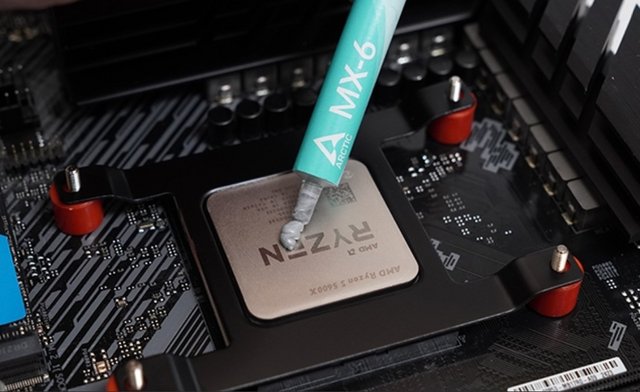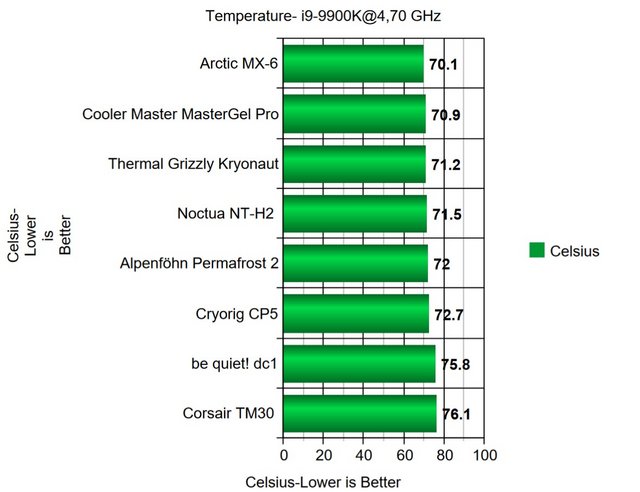-
Arctic MX-6
Introduction
You know that the Thermal compound is one of the most important components of any liquid cooling system, and it’s extremely useful for keeping your CPU and other components at a suitable temperature. If you’re building a liquid cooling system for your PC, you’ll want to consider the use of a thermal compound for your CPU’s cooling. Arctic is renumbering the MX thermal pastes (from 5 to 6) faster than ever before. The MX-5 arrived just last year, but earlier this year there was a report that some batches were drying up prematurely. As a result of such a shortcoming, customer confidence in these thermal pastes may have been so lowered that a new model is the best route to take from a business perspective. The MX-6 thermal paste round out Arctic’s lineup and is actually a replacement for the MX-5, which is now officially listed as a discontinued product. Our review units came in 8g tube, which should last you for a while for most casual users.

Before we move on, let us take a look at the specifications of the Arctic MX-6, as obtained from the manufacturer's website. A formula based on silicone gel is used as a support compound and carbon as a filler to provide the best performance in conductivity, withstanding a temperature range between -50 and 150ºC , much higher than other rivals. The information is completed with a resistivity of 1.8×10 12 Ω·cm and with a breaking voltage of 7.5 kV/mm.

Packaging & Contents
The thermal paste tube is shipped inside a blue paperboard box. This particular variant is 8gm. The salient features of the thermal paste are printed in 4 languages.

The EAN and UPC info labels are printed over here. There is also a QR code on the side hidden by an adhesive that confirms the authenticity of the product.

A Closer Look
The tube has Arctic branding over it. There is an opening on the side which would give a visual indication of the available quantity of the thermal paste in the tube. The attention to such minute detail is appreciated.

Regarding materials, Arctic says that MX-6 is carbon filler-based and features a silicone gel as a carrier for optimal distribution and even contact pressure. MX-6 remains a non-conductive paste, and it isn’t capacitive either, eliminating the risk of short circuits or discharges caused by messy applications or accidents. Arctic says an application should be good for up to eight years with this new formula. The Arctic MX-6, according to the manufacturer’s specifications, is supposed to have a very similar density (2.6 g/cm3) to the MX-5. The viscosity of the MX-6 is 45,000 Poise.
Performance
When the paste was placed on the IHS, it gave the impression that it is almost liquid (low Viscosity). The quantity shown in the picture is not used as it is only to show the thermal paste. A blob method was used to test the thermal performance. The surfaces of processor chips and cooler floors are covered with microscopic dents. Arctic‘s MX-6 thermal paste is composed of carbon micro-particles which fill these cavities guaranteeing that heat is dissipated efficiently from the heat source. Please keep in mind that the thermal conductivity of the thermal paste is much lower than the thermal conductivity of metals likes aluminum or copper since aluminum has 205 W/mK and copper has 385 W/mK whereas the majority of the thermal pastes have up to 5 W/mK ratings with a few ranging up to 14 W/mK. This is very why we would want a thin layer of the thermal paste on the surface of the heat source. The IHS of the CPU is nickel-coated copper whereas the base of the cooler is copper or nickel-coated copper. The too thick or too thin thermal paste would not help result in efficient thermal conductivity since too sparse or too thick to even spread out would be counterproductive.

Applying the Arctic MX-6 is the same as any other thermal paste. Simply unscrew the cap at one end of the syringe and apply pressure to the plunger to get the content out of the barrel. The MX-6 paste itself is grey in color. The paste is carbon microparticle-based with no electrically conductive nor capacitive properties. During the application process, I found the Arctic MX-6 to flow a little faster than I thought it would, but overall, it was not runny enough to become a concern. I put the paste on an Intel Core i7-9900K CPU, which has a relatively small integrated heatspreader. Therefore, a pea-sized amount in the middle was sufficient. If you plan to use it on an AMD Ryzen CPU or larger surface, an alternate pattern or use of the included spatula is highly recommended.

How did the new Arctic MX-6 compare against industry-leading products like the Noctua NT-H2? To give you a straight answer, very well. Let me start off with the most obvious reason why: Its thermal conductivity performance.
Test System:
Bench table- Banchetto 101
Motherboard- Asus ROG Maximus XI Extreme
Cpu- Intel Core i9-9900K
Cpu Cooler- Corsair H110i RGB Platinum
Memory- G.Skill TridentZ Royal DDR4 @ 4000 MHz
VGA- Nvidia GeForce RTX 2080 Ti Founders Edition
PSU- Riotoro Enigma 850W G2
Storage- SSD Corsair Force Series MP510 960 GB
OS- Windows 10 64 bits
To force the processor and perform the temperature measurements we use Aida64 with its stability test activated for the processor and memories.
The stress test is maintained for 10 minutes and the average for the following minute is performed , calculating the average for all the nuclei.
The processor voltage is fixed at 1.25V and the cores are kept at a fixed 4.70GHz during the test. The ambient temperature has been controlled during the tests, staying at around 20ºC.

As we can see in the previous graph, the winner of our comparison of thermal compounds is none other than the new Arctic MX-6 , opening a range of up to 6º difference with the worst of its rivals. The other aspect that has impressed us the most from our analysis is that the Corsair TM30 performs so little, since it shows itself to be one of the worst thermal pastes. We can summarize that all tested thermal paste do their job very well. The difference between the first place and last place thermal pastes are measurable, yes, however it would probably make the difference between crashing or setting a new OC world record in the rarest of cases.
Final Thoughts
Production of the MX-5 clearly didn’t go quite as expected, with Arctic identifying some batches as problematic due to oil separation from the rest of the mass. We don’t know exactly what was behind the discontinuation of the MX-5 thermal paste, but it was apparently easier to release a model with new naming. The main reason could perhaps be a different, easier manufacturing process for Arctic, and it can’t be ruled out that there wasn’t much interest in the MX-5 because it had profiled itself as a “risky” paste, whereas there are plenty of “reliable” ones on the market that hold up well. That model IS replaced by the MX-6, which from our test follow up the successful MX-2, which, by the way, is still selling. It's not the most straightforward task to choose a good thermal paste as you can see that there are plenty of products on the market. The decision of picking up the best one depends on your needs. The choice of thermal paste is essential when you're overclocking the CPU (although it's becoming more and more limited these years). This scenario is mainly applicable when stability is to be achieved, every degree can count to gain it. According to the test results, the best thermal paste in our test is the Arctic MX-6. The MX-6 has low viscosity making it more liquid than the MX-5. Hence it is easy to apply. Arctic claims each application has an 8-year durability, whereas Noctua only promises 5 with their NT-H2. To be honest, I have never had thermal paste go bad, not to mention most enthusiast do not use their computer for that long. Even if some did, chances are that the cooler will be removed at some point, which would have required a thermal paste reapplication anyway. One inconvenient of this product is the non-included spatula on simple versions to evenly spread the thermal paste.

As displayed on the testing chart, we compared some top products on the market, and Arctic MX-6 appears to beat the competitors. Yet, finding the best thermal paste for your CPU may take a lot of time, money, and failures, but once found, it can extend your rig’s lifetime. Arctic MX-6 overcoming the drawbacks generated by the MX-5 version to be a sales success. Typically, the best-selling, 4-gram pack is priced at 9,09 EUR. The smaller tube (2 grams) with MX-6 cost 7,79 EUR and the largest (8 grams), with the lowest price per gram, 11,69 EUR. The medium pack with 4 g of paste is available with a set of five cleaning wipes for 8.49 EUR.

Last edited by testman78; 12-09-2022 at 05:06 AM.
 Posting Permissions
Posting Permissions
- You may not post new threads
- You may not post replies
- You may not post attachments
- You may not edit your posts
-
Forum Rules














 Reply With Quote
Reply With Quote

Bookmarks